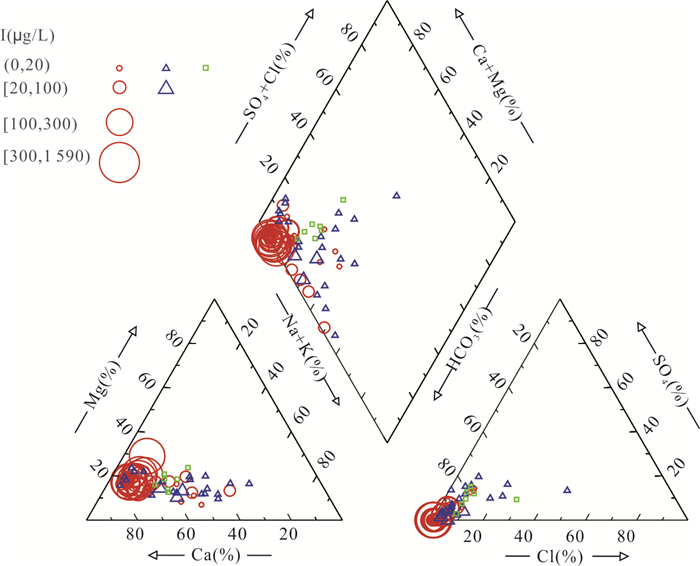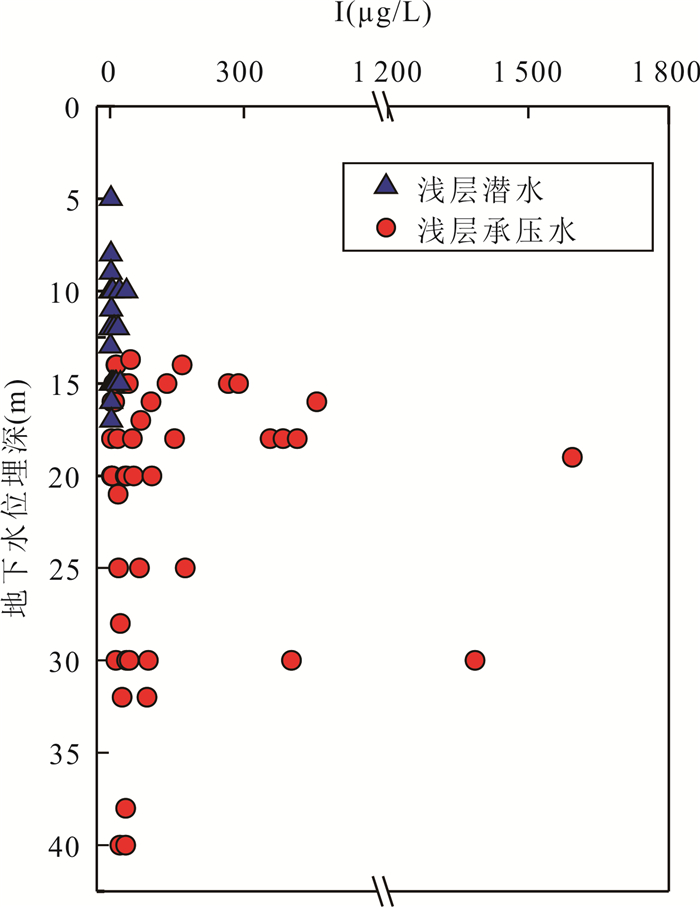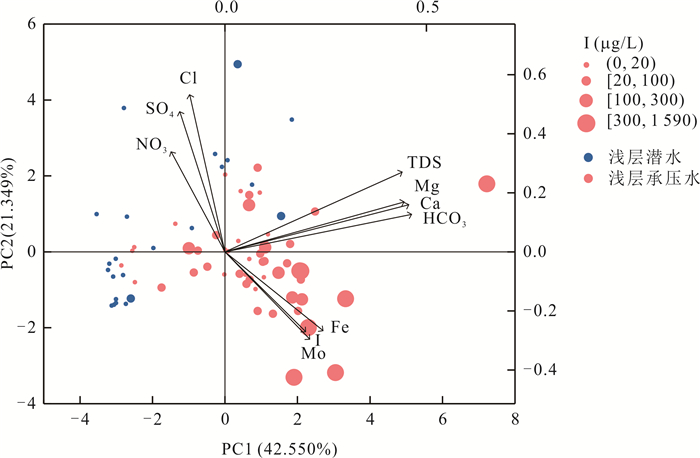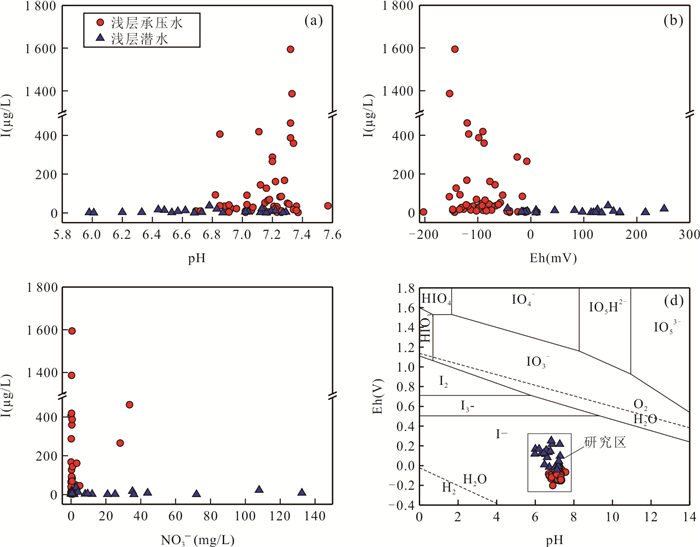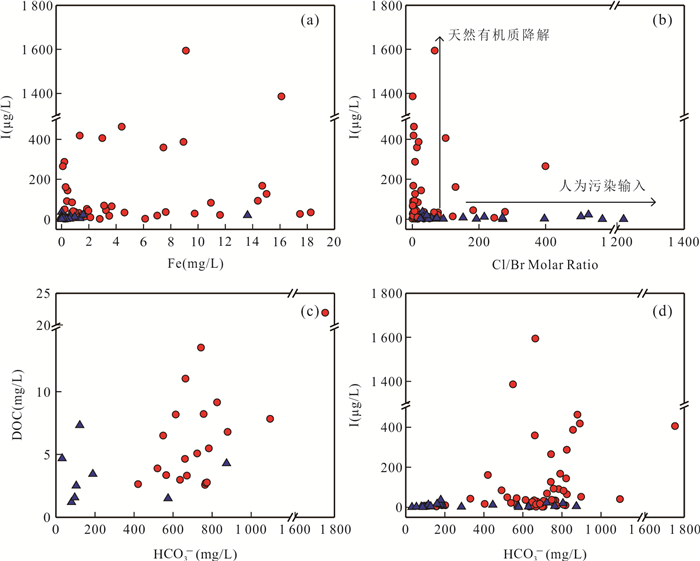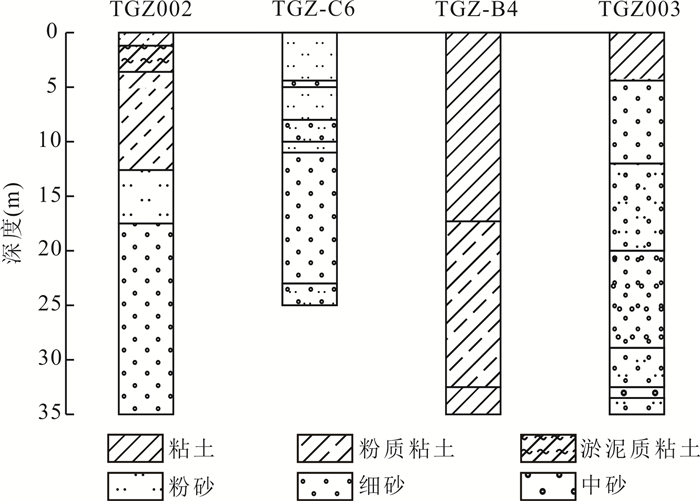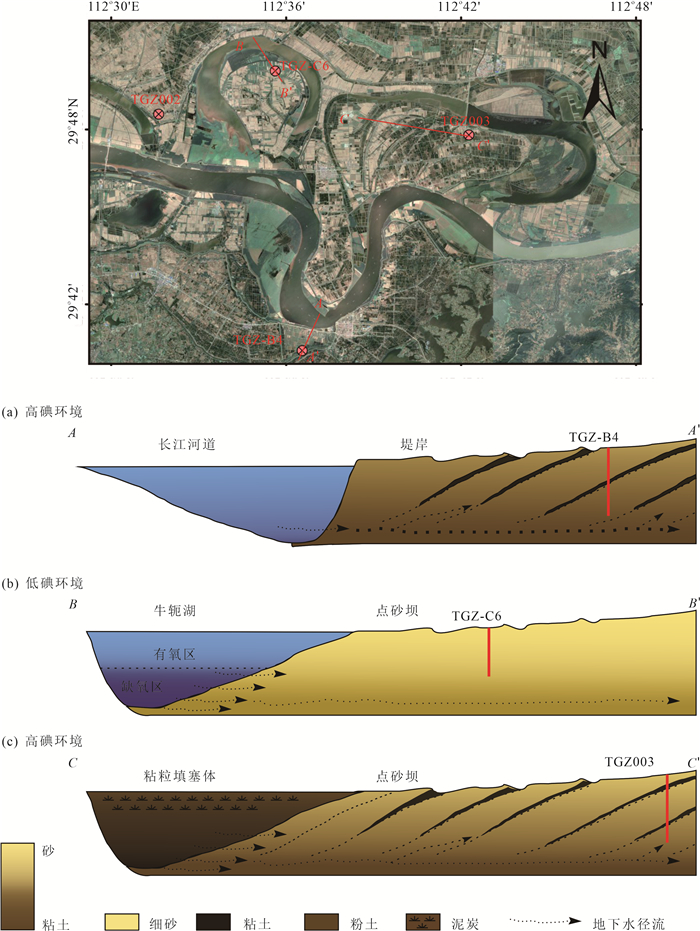Occurrence and Formation of High Iodine Groundwater Inoxbows of the Middle Reach of the Yangtze River
-
摘要: 高碘地下水(碘浓度大于100 μg/L)广泛分布于我国沿海地区和干旱内陆盆地,威胁近千万人口的饮水安全,但目前对湿润区河湖平原地下水中碘的分布与成因机制的认识还十分薄弱.通过采集长江中游故道区75组浅层地下水样品和7组地表水样品进行了水化学分析,查明了地下水中碘的空间分布特征,并运用主成分分析识别了碘富集的水环境要素和水文地球化学过程,并结合4个不同位置的钻孔岩性特征探讨了沉积环境演化对地下水中碘富集的控制作用.研究发现地下水中碘的浓度范围为0.78~1 590 μg/L,其中25%样品超过我国水源性高碘地区水碘含量判定值(100 μg/L).高碘地下水主要赋存于长江河曲凹岸和粘土充填的牛轭湖区的浅层承压含水层.长江中游故道埋藏的丰富有机质形成的强还原环境有利于碘从沉积物释放至地下水中,微生物介导下沉积物有机质降解和铁的氢氧化物还原性溶解是区内高碘地下水形成的主要水文地球化学过程.牛轭湖区后期填充的低渗透率粘粒填塞体和河曲凹岸沉积的厚层粘土层创造了利于碘富集的封闭且水流滞缓的地下水环境.Abstract: High iodine groundwater (iodine concentration greater than 100 μg/L) is widely distributed in coastal areas and arid inland basins in China, threatening the drinking water safety of nearly ten million people, but the understanding of the distribution andformationof iodine in groundwater in humid areas is still very weak. In this study, 75 shallow groundwater samples and 7 surface water samples were collected fromoxbowsof the middle reach of the Yangtze River for hydrogeochemical analysis, the spatial distribution characteristics of iodine in groundwater were identified, the water environmental factors and hydrogeochemical process of iodine enrichment were identified by principal component analysis, and the control effect of sedimentary environment evolution on iodine enrichment was discussed through the lithological analysis of four boreholes at different locations. The concentration of iodine in groundwater ranged from 0.78 μg/L to 1 590 μg/L, and 25% of the samples exceed the determination value of water iodine content in water source areas with high iodine content in China (100 μg/L). The high iodine groundwater mainly occurs in the shallow confined aquifer, distributed in the concave bank of the Yangtze River and the clayfilled oxbow lake. The strong reducing environment rich in organic matter buried under the deposition in oxbows of the middle reach of Yangtze River is conducive to the release of iodine from the sediments to groundwater. Microbially degradation of organic matter and reductive dissolution of iron hydroxide in aquifer sediments are the main hydrogeochemical processes controlling the formation of high iodine groundwater in the study area. The low-permeability clay packing in the later period of the oxbow lake and the thick clay layer deposited on the concave bank of the river meander created a closed and stagnant groundwater environment for iodine enrichment.
-
图 5 研究区地下水碘含量与pH(a)、Eh(b)、NO3-(c)的关系图;(d)碘的pH-Eh图(据Fuge and Johnson, 2015绘制)
Fig. 5. Relationship between groundwater iodine concentration and pH (a), Eh (b), NO3-(c); (d)Eh/pH diagram for iodine (revised from Fuge and Johnson, 2015).
表 1 研究区水样水化学指标统计
Table 1. Statistics of water sample chemical indicators in the study area
参数 地表水 浅层潜水 浅层承压水 最小值 最大值 平均值 中位数 变异系数 最小值 最大值 平均值 中位数 变异系数 最小值 最大值 平均值 中位数 变异系数 pH 7.57 9.26 8.22 8.16 0.06 5.98 7.29 6.76 6.78 0.06 6.69 7.57 7.14 7.18 0.03 Eh(mV) 43.6 217 138 135 0.41 -43.80 252 90.10 114 0.97 -203 11.7 -90.6 -93.2 -0.5 DO(mg/L) 6.72 11.2 8.48 8.07 0.18 0.86 5.32 2.89 2.51 0.48 < 0.01 6.6 2.21 1.76 0.71 Na(mg/L) 4.66 15.9 10.8 9.92 0.41 4.63 46.9 15.7 13.3 0.63 6.16 96.1 18.6 14.6 0.75 Mg(mg/L) 6.74 17.4 10.8 9.9 0.34 4.23 63.6 19.3 8.37 0.89 4.39 128 35 34.8 0.5 K(mg/L) 1.8 6.02 3.59 3.27 0.41 0.39 41.3 7.47 3.94 1.50 0.44 111 5.71 3.11 2.63 Ca(mg/L) 23 43.8 35.5 37.8 0.22 14.1 194 72.1 37.3 0.87 32.4 273 137 142 0.32 Cl-(mg/L) 11.3 64.1 22.5 16 0.83 3 84.6 23.7 18.8 0.91 < 0.01 57.8 12 5.20 1.04 NO3-(mg/L) 0 5.71 1.95 0.54 1.23 < 0.01 132 22.6 4.05 1.60 < 0.01 33.6 1.78 0.45 3.34 SO42-(mg/L) 4.05 36.5 20 18.5 0.5 < 0.01 100 24.9 17.9 1.02 < 0.01 52.9 8 < 0.01 1.74 HCO3-(mg/L) 102 192 154 157 0.21 32 874 317 176 0.89 157 1 750 681 698 0.36 TDS(mg/L) 120 229 182 193 0.24 78 872 344 186 0.76 183 1 320 558 573 0.33 NH4⁃N(mg/L) 0.10 0.64 0.31 0.28 0.62 0.01 3.2 0.46 0.11 1.87 0.04 71 4.50 1.55 2.45 Fe2+(mg/L) - - - - - < 0.01 13.8 1.32 0.01 2.65 0.12 15.4 4.05 2.03 1.07 Fe(mg/L) < 0.01 0.03 0.01 0.01 1 < 0.01 13.6 0.87 0.10 3.24 0.09 18.3 4.36 1.79 1.2 I(μg/L) 1.3 10.8 5.14 4.54 0.71 0.78 36.8 8.24 4.55 1.09 2.44 1 590 142 35.7 2.11 DOC(mg/L)* - - - 7.83 - 1.21 7.33 3.32 2.98 0.63 2.58 21.9 6.64 5.29 0.71 注:-.表示数据未获取;*.仅29组水样测试DOC含量,其中地表水样品1组,浅层潜水样品8组,浅层承压水20组. 表 2 研究区最大方差法旋转主成分荷载
Table 2. Principal component loadings with varimax rotationin the study area
变量 PC1 PC2 PC3 TDS 0.979 0.118 0.106 Ca 0.951 0.209 -0.031 Mg 0.948 0.135 -0.065 HCO3- 0.968 0.151 -0.146 I- 0.123 0.742 -0.055 Fe 0.233 0.667 -0.159 Mo 0.117 0.812 -0.050 Cl 0.058 -0.184 0.881 NO3- -0.175 0.078 0.814 SO42- 0.055 -0.442 0.581 特征值 4.255 2.135 1.264 贡献率(%) 42.550 21.349 12.638 累计贡献率(%) 42.550 63.899 76.537 注:加粗表示显著荷载. -
Allard, S., Von, G. U., Sahli, E., et al., 2009. Oxidation of Iodide and Iodine on Birnessite (δ-MnO2) in the pH Range 4~8. Water Research, 43: 3417-3426. https://doi.org/10.1016/j.watres.2009.05.018 Álvarez, F., Reich, M., Snyder, G., et al., 2016. Iodine Budget in Surface Waters from Atacama: Natural and Anthropogenic Iodine Sources Revealed by Halogen Geochemistry and Iodine-129 Isotopes. Applied Geochemistry, 68: 53-63. https://doi.org/10.1016/j.apgeochem.2016.03.011 Andersson, M., Karumbunathan, V., Zimmermann, M. B., 2012. Global Iodine Status in 2011 and Trends over the Past Decade. The Journal of Nutrition, 142: 744-750. https://doi.org/10.3945/jn.111.149393 Barikmo, I., Henjum, S., Dahl, L., et al., 2011. Environmental Implication of Iodine in Water, Milk and other Foods Used in Saharawi Refugees Camps in Tindouf, Algeria. Journal of Food Composition and Analysis, 24: 637-641. https://doi.org/10.1016/j.jfca.2010.10.003 Bridge, J. S., 2003. Rivers and Floodplains. Blackwell, Oxford, 504. Burgess, W. G., Hoque, M. A., Michael, H. A., et al., 2010. Vulnerability of Deep Groundwater in the Bengal Aquifer System to Contamination by Arsenic. Nature Geoscience, 3: 83-87. https://doi.org/10.1038/ngeo750 Dai, J. L., 2004. Bioavailability of Iodine in Soil-Plant System(Dissertation). Shandong Agricultural University, Qingdao(in Chinese with English abstract). Deng, Y. M., 2008. Geochemical Processes of High Arsenic Groundwater System at Western Hetao Basin(Dissertation). China University of Geosciences, Wuhan(in Chinese with English abstract). Delange, F., de Benoist, B., Pretell, E., et al., 2001. Iodine Deficiency in the World: Where do We Stand at the Turn of the Century? Thyroid, 11: 437-447. https://doi.org/10.1089/105072501300176390 Donselaar, M. E., Bhatt, A. G., Ghosh, A. K., 2017. On the Relation between Fluvio-Deltaic Flood Basin Geomorphology and the Wide-Spread Occurrence of Arsenic Pollution in Shallow Aquifers. Science of the Total Environment, 574: 901-913. https://doi.org/10.1016/j.scitotenv.2016.09.074 Du, Y., Deng, Y. M., Ma, T., et al., 2018, Hydrogeochemical Evidences for Targeting Sources of Safe Groundwater Supply in Arsenic-Affected Multi-Level Aquifer Systems. Science of the Total Environment, 645: 1159-1171. https://doi.org/10.1016/j.scitotenv.2018.07.173 Duan, L., Wang, W., Sun, Y., et al., 2016. Iodine in Groundwater of the Guanzhong Basin, China: Sources and Hydrogeochemical Controls on Its Distribution. Environmental Earth Sciences, 75(11): 1-11. https://doi.org/10.1007/s12665-016-5781-4 Fuge, R., Johnson, C. C., 2015. Iodine and Human Health, the Role of Environmental Geochemistry and Diet, a Review. Applied Geochemistry, 63: 282-302. https://dx.doi.org/10.1016/j.apgeochem.2015.09.013 Gan, Y. Q., Zhao, K., Deng, Y. M., et al., 2018. Groundwater Flow and Hydrogeochemical Evolution in the Jianghan Plain, Central China. Hydrogeology Journal, 26: 1609-1623. https://doi.org/10.1007/s10040-018-1778-2 Ghosh, D., Kumar, S., Donselaar, M. E., 2020. Organic Carbon Transport Model of Abandoned River Channels: a Motif for Floodplain Geomorphology Influencing Biogeochemical Swaying of Arsenic. Science of the Total Environment, 762: 144400. https://doi.org/10.1016/j.scitotenv.2020.144400 Guo, X. X., 2014. Arsenic Mobilization and Transport in Shallow Aquifer Systems of Jianghan Plain(Dissertation). China University of Geosciences, Wuhan(in Chinese with English abstract). Gu, Y. S., Guan, S., Ma, T., et al., 2018. Quaternary Sedimentary Environment Documented by Borehole Stratigraphical Records in Eastern Jianghan Basin. Earth Science, 43(11): 3989-4000(in Chinese with English abstract). Guo, H. M., Li, Y., Zhao, K., et al., 2011. Removal of Arsenite by Synthetic Siderite: Behaviors and Mechanisms. Journal of Hazardous Materials, 186: 1847-1854. https://doi.org/10.1016/j.jhazmat.2010.12.078 Guo, H. P., Zhang, Z. C., Cheng, G. M., et al., 2015. Groundwater-Derived Land Subsidence in the North China Plain. Environmental Earth Sciences, 74: 1415-1427. https://doi.org/10.1007/s12665-015-4131-2 Johnson, C.C., 2003. The Geochemistry of Iodine and Its Application to Environmental Strategies for Reducing the Risk from Iodine Deficiency Disorders, Report CR/03/057N. British Geological Survey, London. Jolliffe, I.T., 2002. Principal Component Analysis. 2nd Edition. Springer-Verlag, New York. Kaiser, H.F., 1960. The Application of Electronic Computers to Factor Analysis. Educational and Psychological Measurement, 20: 141-151. https://doi.org/10.1177/001316446002000116 Kaplan, D. I., Denham, M. E., Zhang, S. J., et al., 2014. Radioiodine Biogeochemistry and Prevalence in Groundwater. Critical Reviews in Environmental Science and Technology, 44: 2287-2335. https://doi.org/10.1080/10643389.2013.828273 Koh, D. C., Mayer, B., Lee, K. S., et al., 2010. Land-Use Controls on Sources and Fate of Nitrate in Shallow Groundwater of an Agricultural Area Revealed by Multiple Environmental Tracers. Journal of Contaminant Hydrology, 118 (1-2): 62-78. https://doi.org/10.1016/j.jconhyd.2010.08.003 Li, J. X., 2014. Geochemistry of High Iodine Groundwater System of Datong Basin, Northern China(Dissertation). China University of Geosciences, Wuhan(in Chinese with English abstract). Lu, Z.J., Deng, Y.M., Du, Y., et al., 2017. EEMs Characteristics of Dissolved Organic Matter and Their Implication in High Arsenic Groundwater of Jianghan Plain. Earth Science, 42(5): 771-782(inChinese with English abstract). Li, J. X., Wang, Y. X., Guo, W., et al., 2014. Iodine Mobilization in Groundwater System at Datong Basin, China: Evidence from Hydrochemistry and Fluorescence Characteristics. Science of the Total Environment, 468-469: 738-745. https://doi.org/10.1016/j.scitotenv.2013.08.092 Li, J. X., Wang, Y. X., Xie, X. J., et al., 2013. Hydrogeochemistry of High Iodine Groundwater: a Case Study at the Datong Basin, Northern China. Environmental Science Processes Impact, 15: 848-859. https://doi.org/10.1039/c3em30841c Lind, P., Langsteger, W., Molner, M., et al., 1998. Epidemiology Thyroid Diseases in Iodine Sufficiency. Thyroid, 8(12): 1179-1183. https://doi.org/10.1089/thy.1998.8.1179 McArthur, J. M., Sikdar, P. K., Hoque, M. A., et al., 2012, Waste-Water Impacts on Groundwater: Cl/Br Ratios and Implications for Arsenic Pollution in the Bengal Basin and Red River Basin, Vietnam. Science of the Total Environment, 437: 390-402. https://doi.org/10.1016/j.scitotenv.2012.07.068 Nath, B., Sahu, S. J., Jana, J., et al., 2008. Hydrochemistry of Arsenic-Enriched Aquifer from Rural West Bengal, India: A Study of Arsenic Exposure and Mitigation Option. Water Air and Soil Pollution, 190(1/4): 95-113. https://doi.org/10.1007/s11270-007-9583-x Otosaka, S., Schwehr, K. A., Kaplan, D. I., et al., 2011. Factors Controlling Mobility of 127I and 129I Species in an Acidic Groundwater Plume at the Savannah River Site. Science of the Total Environment, 409: 3857-3865. https://doi.org/10.1016/j.scitotenv.2011.05.018 Roti, E., Uberti, E. D., 2001. Iodine Excess and Hyperthyroidism. Thyroid, 11: 493-500. https://doi.org/10.1089/105072501300176453 Seigo, A., Mizuyo, K., Satoshi, H., et al., 2003. Microbial Participation in Iodine Volatilization from Soils. Environmental Science Technology, 37: 3885-90. https://doi.org/10.1021/es0210751 Steinberg, S. M., Schmett, G. T., Kimble, G., et al., 2008. Immobilization of Fission Iodine by Reaction with INsoluble Natural Organic Matter. Journal of Radioanalytical and Nuclear Chemistry, 277: 175-183. https://doi.org/10.1007/s10967-008-0727-2 Sun, Y., Zhou, J. L., Liang, X., et al., 2020. Distribution and Genesis of Shallow High-Iodine Groundwater Insouthern Margin of the Tarim Basin: A Case Study of Plain Area in Minfeng County, Xinjiang. Earth Science(in Chinese with English abstract). Tang, Q. F., Xu, Q., Zhang, F. C., et al., 2013. Geochemistry of Iodine-Rich Groundwater in the Taiyuan Basin of Central Shanxi Province, North China. Journal of Geochemical Exploration, 135: 117-123. https://doi.org/10.1016/j.gexplo.2012.08.019 Togo, Y. S., Takahashi, Y., Amano, Y., et al., 2016. Age and Speciation of Iodine in Groundwater and Mudstones of the Horonobe Area, Hokkaido, Japan: Implications for the Origin and Migration of Iodine during Basin Evolution. Geochimica et Cosmochimica Acta, 191: 165-186. https://doi.org/10.1016/j.gca.2016.07.012 Voutchkova, D. D., Ernstsen, V., Kristiansen, S. M., et al., 2017. Iodine in Major Danish Aquifers. Environmental Earth Sciences, 76: 447. https://doi.org/10.1007/s12665-017-6775-6 Wang, A. M., 2016. Response of Sediments of Oxbows in the Middle Reaches of the Yangtze River to Human Activities in Recent 100 Years(Dissertation). Shanghai Normal University, Shanghai(in Chinese with English abstract). Whitehead, D.C., 1984. The Distribution and Transformations of Iodine in the Environment. Environment International, 10: 321-339. https://doi.org/10.1016/0160-4120(84)90139-9 Wang, L. X., Liang, X., Li, J., 2020. Analysis of Origin of Groundwater in Jianghan Plain Based on Typical Drillings. Earth Science, 45(2): 701-710(in Chinese with English abstract). Xue, X. B., Li, J. X., Qian, K., et al., 2018. Spatial Distribution and Mobilization of Iodine in Groundwater System of North China Plain: Taking Hydrogeological Section from Shijiazhuang, Hengshui to Cangzhou as an Example. Earth Science, 43(3): 910-921 (in Chinese with English abstract). Xue, X. B., Li, J. X., Xie, X. J., et al., 2019. Effects of Depositional Environment and Organic Matter Degradation on the Enrichment and Mobilization of Iodine in the Groundwater of the North China Plain. Science of the Total Environment, 686: 50-62. https://doi.org/10.1016/j.scitotenv.2019.05.391 Xu, F., Ma, T., Shi, L., et al., 2012. Hydrogeochemical Characteristics of High Iodine Groundwater in Hetao Plain, Inner Mongolia. Hydrogeology & Engineering Geology, 39(5): 809-815(inChinese). Xu, C., Zhong, J. Y., Patrick, G., et al., 2012, Molecular Environment of Stable Iodine and Radioiodine (129I) in Natural Organic Matter: Evidence Inferred from NMR and Binding Experiments at Environmentally Relevant Concentrations. Geochimica et Cosmochimica Acta, 97: 166-182. https://doi.org/10.1016/j.gca.2012.08.030 Zimmermann, M. B., 2009. Iodine Deficiency. Endocrine Reviews, 30: 376-408. https://doi.org/10.1210/er.2009-0011 Zhang, E. Y., Wang, Y. Y., Qian, Y., et al., 2013. Iodine in Groundwater of the North China Plain: Spatial Patterns and Hydrogeochemical Processes of Enrichment. Journal of Geochemical Exploration, 135: 40-53. https://doi.org/10.1016/j.gexplo.2012.11.016 Zhang, S. J., Xu, C., Creeley, D., 2013. Iodine-129 and Iodine-127 Speciation in Groundwater at the Hanford Site, U.S. : Iodate Incorporation into Calcite. Environmental Science Technology, 47: 9635-9642. https://doi.org/10.1021/es401816e Zhou, Y., Wang, Y. X., Li, Y. L., et al., 2013. Hydrogeochemical Characteristics of Central Jianghan Plain, China. Environmental Earth Sciences, 68: 765-778. https://doi.org/10.1007/s12665-012-1778-9 Zhang, E. Y., Zhang, F. C., Qian, Y., et al., 2010. Distribution Characteristics and Enlightenment of High Iodine Groundwater in Typical Areas of China. Geology in China, 37(3): 797-802(inChinese). 戴九兰, 2004. 碘在土壤-植物系统中的生物有效性(博士学位论文). 青岛: 山东农业大学. 邓娅敏, 2008. 河套盆地西部高砷地下水系统中的地球化学过程研究(博士学位论文). 武汉: 中国地质大学. 郭欣欣, 2014. 江汉平原浅层含水层系统中砷释放与迁移过程研究(博士学位论文). 武汉: 中国地质大学. 顾延生, 管硕, 马腾, 等, 2018. 江汉盆地东部第四纪钻孔地层与沉积环境. 地球科学, 43(11): 3989-4000. doi: 10.3799/dqkx.2018.324 李俊霞, 2014. 大同盆地高碘地下水系统地球化学研究(博士学位论文). 武汉: 中国地质大学. 鲁宗杰, 邓娅敏, 杜尧, 等, 2017. 江汉平原高砷地下水中DOM三维荧光特征及其指示意义. 地球科学, 42(5): 771-782. doi: 10.3799/dqkx.2017.065 孙英, 周金龙, 梁杏, 等, 2020. 塔里木盆地南缘浅层高碘地下水的分布及成因: 以新疆民丰县平原区为例. 地球科学. 王阿敏, 2016. 近百年来长江中游牛轭湖沉积对人类活动的响应(硕士学位论文). 上海: 上海师范大学. 王露霞, 梁杏, 李静, 2020. 基于典型钻孔的江汉平原地下水成因分析. 地球科学, 45(2): 701-710. doi: 10.3799/dqkx.2018.363 徐芬, 马腾, 石柳, 等, 2012. 内蒙古河套平原高碘地下水的水文地球化学特征. 水文地质工程地质, 39(5): 809-815. https://www.cnki.com.cn/Article/CJFDTOTAL-SWDG201205001.htm 薛肖斌, 李俊霞, 钱坤, 等, 2018. 华北平原原生富碘地下水系统中碘的迁移富集规律: 以石家庄-衡水-沧州剖面为例. 地球科学, 43(3): 910-921. doi: 10.3799/dqkx.2017.564 张二勇, 张福存, 钱永, 等, 2010. 中国典型地区高碘地下水分布特征及启示. 中国地质, 37(3): 797-802. doi: 10.3969/j.issn.1000-3657.2010.03.036 -









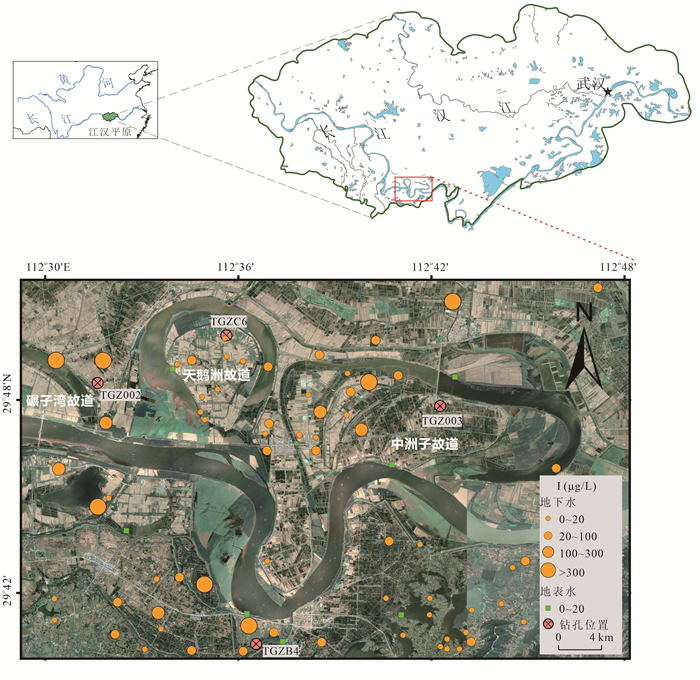
 下载:
下载:
